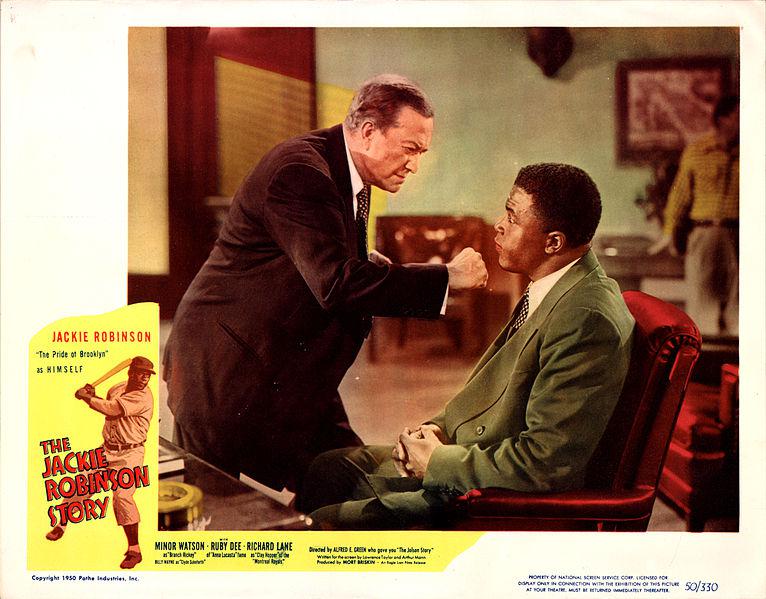The movie 42 opens this weekend, a Hollywood biopic celebrating Jackie Robinson’s role as the first black player in the modern era of Major League Baseball. Starring newcomer Chadwick Boseman as Robinson and Harrison Ford as Brooklyn Dodgers president Branch Rickey, the man who signed Robinson, the film does a serviceable job of portraying the steps it took for history to be made.
This isn’t the first time Robinson’s life has been the subject of a film, of course—and it’s worth revisiting that initial attempt, which, while not a great movie, is a notable historical document. That’s mostly because The Jackie Robinson Story, from 1950, stars none other than Jackie Robinson himself.
Both 42 and The Jackie Robinson Story—which is in the public domain, and can be watched in full above—cover fairly obvious moments in Robinson’s rise to prominence: spring training with the Montreal Royals (a farm team), the petition signed by some of the Dodgers who didn’t want him on their team, the Dodgers’ clinching of the pennant during his first season. Some of the pivotal scenes even overlap a bit in their dialogue. In both 42 and The Jackie Robinson Story, when Rickey tells Robinson that he must resist provocation by hecklers, the scripts echo a moment made famous by history. Robinson is said to have asked, “Mr. Rickey, are you looking for a Negro who is afraid to fight back?” “Robinson, I’m looking for a ballplayer with guts enough not to fight back,” Rickey reportedly said.
In the best scene from 42, Phillies manager Ben Chapman rattles off an incredible number of slurs and insults while Robinson is at the plate. Robinson contains himself, but strikes out, then retreats to the dugout, where he takes his anger out on his bat, and finally breaks down in tears. No scene in The Jackie Robinson Story comes as close to depicting what it must have felt like for the real-life hero to endure such vitriol on a daily basis. When, in The Jackie Robinson Story, some folks in the stands taunt Robinson with a black cat, he just takes it from them and gently carries it into the dugout.
The film was made in the midst of the Jim Crow era, just three years after Robinson made his Dodgers debut, and it treads rather lightly on the matter of racism. As Martin Edlund pointed out a few years ago in Slate, Robinson is characterized as stoic and timid, lacking any of the outspokenness he demonstrated off the field. In his autobiography, Robinson wrote: “I had to fight hard against loneliness, abuse and the knowledge that any mistake I made would be magnified because I was the only black man out there. Many people resented my impatience and honesty, but I never cared about acceptance as much as I cared about respect.” Robinson’s internal struggle to maintain his cool, and the burden he carried as the “first” and “only,” doesn’t ever fully come to life on screen.
The Jackie Robinson Story covers more biographical ground than 42, including his years at UCLA and his drafting into the Army. Not surprisingly, though, his refusal to move to the back of a military bus, which led to a court-martial and a transfer to another base, is completely ignored. Instead, Robinson is shown simply doing his patriotic duty. (As Peter Dreir points out at The Atlantic, The Court-Martial of Jackie Robinson, a TV movie starring Andre Braugher, covers that incident.)
The script is stiff, and Robinson is not a great actor, but watching him recreate his own life in the middle of its pioneering progress is fascinating. And it only becomes more so when you grasp the full context of Robinson’s performance. The film ends with Robinson speaking before the House Un-American Activities Committee, as he had in real life the year before. He was called to counter a claim Paul Robeson had supposedly made that black Americans wouldn’t support the country if it went to war with the Soviets. “I do know that democracy works for those who are willing to fight for it,” Robinson testifies. “And I’m sure it’s worth defending.”
The movie depicts this speech as a purely patriotic paean to the American way—and follows it with a montage that includes the Statue of Liberty, as a voice speaks of living “in a country that is truly free.” But as Paul Robeson, Jr. pointed out years later, Robinson’s actual speech was more complicated than many people realized. After saying that he cherished his religious freedom, and that he was sure most black Americans felt the same way, Robinson added, “that doesn’t mean that we’re going to stop fighting race discrimination in this country until we’ve got it licked. It means that we’re gonna fight it ever harder, because our stake in the future is so big.” These lines don’t show up in either film.
